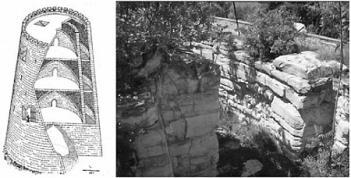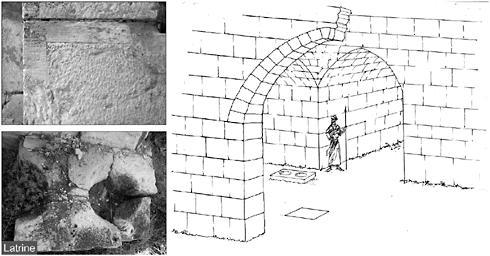Muslim Fortresses in the Levant: Between Crusaders and Mongols (90 page)
Read Muslim Fortresses in the Levant: Between Crusaders and Mongols Online
Authors: Kate Raphael
Tags: #Arts & Photography, #Architecture, #Buildings, #History, #Middle East, #Egypt, #Politics & Social Sciences, #Social Sciences, #Human Geography, #Building Types & Styles, #World, #Medieval, #Humanities

This tower is the only building attesting to Mamluk construction carried out with stone blocks of outstanding size, the kind that Ibn Shaddād and described as
described as

Figure 4.17
Safad, reconstruction of the central tower. Note the cistern below

Figure 4.18
Safad, reconstruction of the entrance to the central tower. Note the latrines and fine masonry
hirqilī
stones (
Figure 4.19
). The soft limestone of the external wall may have had a few advantages; Duffy suggests that in general an extremely hard stone is considered to be a poor material since it would easily break under the impact of projectiles.
122
The only features shared with Bīlīk’s tower at are the large building blocks and the cistern dug out below the tower. Other than that, the tower at Safad remains unique both in its structure and dimensions.
are the large building blocks and the cistern dug out below the tower. Other than that, the tower at Safad remains unique both in its structure and dimensions.
A water supply that allowed bath-houses
Bath-houses feature in the accounts of both Ibn Shaddād and Dimashqī. Archaeological remains have yet to be found.
From Ibn Shaddād’s description of the water system and the evidence of cisterns, it seems that the fortress at Safad relied on rainwater collected inside the fortress grounds. In addition water was brought from
birkat
(pool)
burj al-yatīm
to a square tower near the gate of the fortress. This pool also supplied the bath-house
123
Dimashqī provides a detailed description of the mechanism of the water-wheel that was built above a well inside the fortress. The well (3.5m in diameter and 64m deep)
124
may have been fed by an underground aquifer as well as rain water collected from the roofs and channeled to the well.
The mosques within the fortress
Baybars returned to Safad after attending to various affairs in the region. Once he arrived, says Ibn , “He went up to the fortress to pray in the tower where he used to sit. Thee he saw a large statue (
, “He went up to the fortress to pray in the tower where he used to sit. Thee he saw a large statue ( ) of St. George. He ordered
) of St. George. He ordered

Figure 4.19
Safad, central round tower. Note the construction and the dimensions of the stone blocks
to tear it out ( ), break it, purify the place and build a
), break it, purify the place and build a instead of it.”
instead of it.”
125
It is difficult to conclude from this account that it occurred in the large round tower,
126
since neither a tower nor a chapel is mentioned by the anonymous French author. Other than the hall that was converted into a mosque, Ibn Shaddād says that the church within the fortress was turned into a mosque.
127
The act of building mosque became an important symbol of Muslim victory. Even in chronicles that only briefly note the reconstruction work, there is often a word or a short sentence referring to the building of a mosque or the conversion of a church into a mosque by the sultan.
The elusive inscription
Our knowledge of the inscription commemorating Baybars’s conquest and reconstruction of Safad comes from Ibn and Maqrīzī.
and Maqrīzī.
128
It was, they say, inserted in the curtain wall, but it has yet to be found:
We wrote in the Psalms (Zabūr) after the message (given to Moses) My servants the righteous, shall inherit the earth.
129
Truly it is the party of Allāh that will achieve felicity.
130
And he ordered this stronghold and its fortification to be renewed and the completion and improvement of its building, after he liberated it from the captivity of the cursed Franks and he restored it to the authority of the Muslim rulers and transferred it from the possession of the Templars to the believers and he returned it to the faith as it was in the beginning. And there he dealt the infidels defeat and sorrow, he exerted great efforts, he replaced unbelief with belief, the sound of bells with the sound of the call to prayer and the Gospel with the Qur’ān. And he took it upon himself to carry earth and stones on his head from the moat together with his entourage. The sultan al-Malik
 , Baybars. And may [God] grant a portion of his [Baybars’ heavenly] remuneration to any Muslim ruler who takes possession of this fortress and any
, Baybars. And may [God] grant a portion of his [Baybars’ heavenly] remuneration to any Muslim ruler who takes possession of this fortress and any
mujāhid
who makes his dwelling in it; and let him [God] not deprive him of mercy, secretly and openly and the [supreme] reward is preserved for the pious until the day of judgment.
131
